VUE
v-bind绑定
<!DOCTYPE html>
<html lang="en" xmlns:v-bind="http://www.w3.org/1999/xhtml">
<head>
<meta charset="UTF-8">
<title>Title</title>
<!-- 导入vue.js -->
<script src="https://cdn.jsdelivr.net/npm/vue@2.5.21/dist/vue.min.js"></script>
</head>
<body>
<!--view层 模板-->
<div id="app">
<span v-bind:title="message">
鼠标停悬几秒查看此处动态绑定的提示信息~
</span>
</div>
<script>
var vm = new Vue({
el:"#app",
// Model层
data:{
message:"hello,vue!"
}
});
</script>
</body>
</html>
v-if/v-else-if/v-else
<!DOCTYPE html>
<html lang="en" xmlns:v-bind="http://www.w3.org/1999/xhtml">
<head>
<meta charset="UTF-8">
<title>Title</title>
</head>
<body>
<!-- 导入vue.js -->
<script src="https://cdn.jsdelivr.net/npm/vue@2.5.21/dist/vue.min.js"></script>
<!--view层 模板-->
<div id="app">
<h1 v-if = "type==='A'">AAA</h1>
<h1 v-else-if = "type==='B'">BBB</h1>
<h1 v-else-if = "type==='C'">CCC</h1>
<h1 v-else>dddd</h1>
</div>
<script>
var vm = new Vue({
el:"#app",
// Model层
data:{
type: "A"
}
});
</script>
</body>
</html>
v-for
<!DOCTYPE html>
<html lang="en">
<head>
<meta charset="UTF-8">
<title>Title</title>
</head>
<body>
<!-- 导入vue.js -->
<script src="https://cdn.jsdelivr.net/npm/vue@2.5.21/dist/vue.min.js"></script>
<!--view层 模板-->
<div id="app">
<li v-for="(item,index) in items">
{{item.message}}---{{index}}
</li>
</div>
<script>
var vm = new Vue({
el:"#app",
// Model层
data:{
items: [
{message: "123"},
{message: "345"}
]
}
});
</script>
</body>
</html>
v-on/Vue.methods
- 方法必须定义在vue的Method对象中 v-on:事件
<!DOCTYPE html>
<html lang="en" xmlns:v-on="http://www.w3.org/1999/xhtml">
<head>
<meta charset="UTF-8">
<title>Title</title>
</head>
<body>
<!-- 导入vue.js -->
<script src="https://cdn.jsdelivr.net/npm/vue@2.5.21/dist/vue.min.js"></script>
<!--view层 模板-->
<div id="app">
<button v-on:click="sayHi">sayHi</button>
<br>
<button v-on:click="smile">smile</button>
</div>
<script>
var vm = new Vue({
el:"#app",
// Model层
data:{
message: "Summer"
},
methods: {//方法必须定义在vue的Method对象中 v-on:事件
sayHi: function(a){
alert(this.message)
},
smile: function(a){
alert(this.message)
}
}
});
</script>
</body>
</html>
v-model
- 表单双向绑定:v-model指令在表单input tesxarea select 元素上双向绑定
<!DOCTYPE html>
<html lang="en">
<head>
<meta charset="UTF-8">
<title>Title</title>
</head>
<body>
<script src="https://cdn.jsdelivr.net/npm/vue@2.5.21/dist/vue.min.js"></script>
<div id="app">
<textarea name="" id="" cols="30" rows="10" v-model="message"></textarea>
{{message}}
<br>
性别:
<input type="radio" name="sex" value="男" v-model="check">男
<input type="radio" name="sex" value="女" v-model="check">女
<p>
选中了:{{check}}
</p>
<br>
下拉框:
<select v-model="select">
<option value="" disabled>--请选择--</option>
<option>A</option>
<option>B</option>
<option>C</option>
<option>D</option>
</select>
value:{{select}}
</div>
<script>
var vm = new Vue({
el:"#app",
// Model层
data:{
message: "Summer",
check:"",
select:""
},
methods: {//方法必须定义在vue的Method对象中 v-on:事件
sayHi: function(a){
alert(this.message)
},
smile: function(a){
alert(this.message)
}
}
});
</script>
</body>
</html>
定义VUE组件
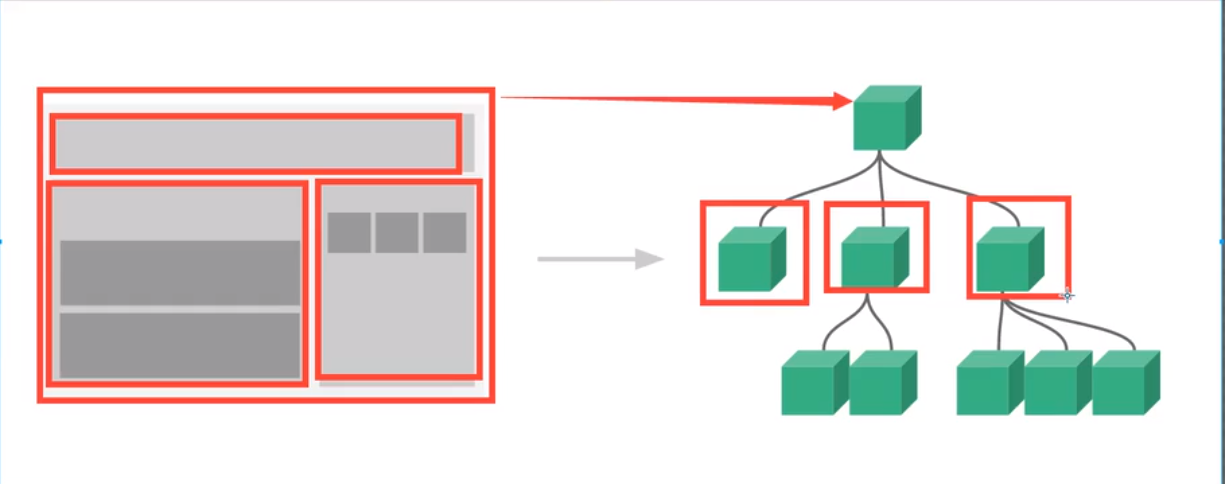
- 定义标签
- 用Vue.component 一个组件名一个对象
- 定义组件名
- 对象中用props绑定参数 template定义模板
<!DOCTYPE html>
<html lang="en">
<head>
<meta charset="UTF-8">
<title>Title</title>
</head>
<body>
<!-- 导入vue.js -->
<script src="https://cdn.jsdelivr.net/npm/vue@2.5.21/dist/vue.min.js"></script>
<!--view层 模板-->
<div id="app">
<!-- 组件:传递给组件中的值:props-->
<summer v-for="item in items" v-bind:bang="item"></summer>
</div>
<script>
//定义一个vue组件
Vue.component("summer",{
props:['bang'],
template: '<li>{{bang}}</li>'
});
var vm = new Vue({
el:"#app",
// Model层
data:{
items: ["Summer","Spring"]
}
});
</script>
</body>
</html>
Axios异步通信
通信一般想到JQuery,但是JQuery操作DOM太频繁,不推荐用
分类:鼠标事件 | jQuery API中文文档(适用jQuery 1.0 - jQuery 3.3.1) (html.cn)
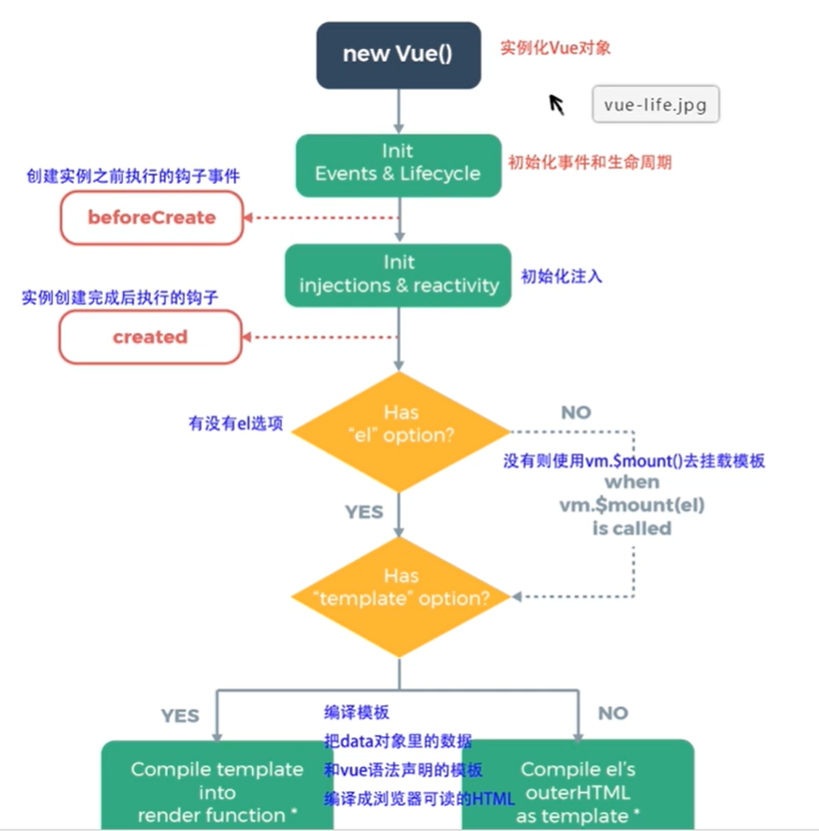
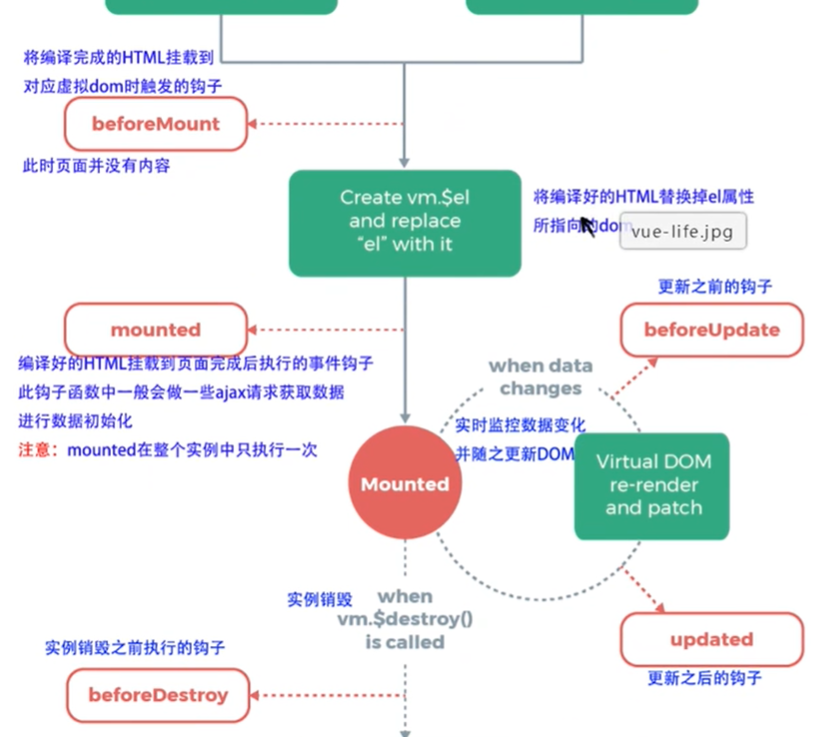
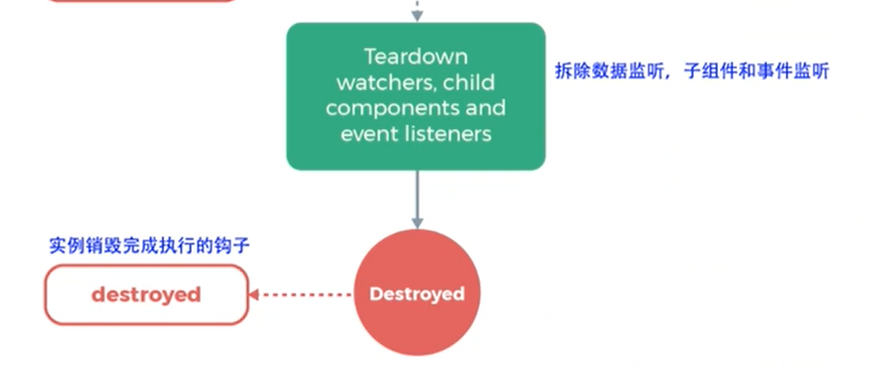
- 钩子函数 链式函数 ES6新特性
data.json
{
"message": "hello,vue!",
"links": [
"a",
"b"
],
"url": "https://www.baidu.com"
}
<!DOCTYPE html>
<html lang="en">
<head>
<meta charset="UTF-8">
<title>Title</title>
<!--v-clock解决闪烁问题 display: none; 没加载前白屏-->
<style>
[v-clock]{
display: none;
}
</style>
</head>
<body>
<!-- 导入vue.js -->
<script src="https://cdn.jsdelivr.net/npm/vue@2.5.21/dist/vue.min.js"></script>
<script src="https://unpkg.com/axios/dist/axios.min.js"></script>
<!--view层 模板-->
<div id="app" v-clock>
<div>{{info.message}}</div>
<div>{{info.links}}</div>
<a v-bind:href="info.url">点我</a>
</div>
<script>
var vm = new Vue({
el: "#app",
//data:{}, vue的data属性
data(){
return{//return的是一个格式
//请求的返回参数合适,必须和json字符串一样
info:{
message:null,
url:null,
links:[]
}
}
},
mounted() { //钩子函数 链式函数 ES6新特性
//jQuery和Ajax都可以在这里处理 但是要处理dom
//axios 用到 data(){return{}}格式即可绑定
axios.get('../data.json').then(response => (this.info=response.data));
}
});
</script>
</body>
</html>
计算属性computed
- 内存中运行:虚拟Dom(相当于缓存)
- 计算属性的主要特性就是为了将不经常变化的计算结果进行缓存,以节约我们的系统开销
<!DOCTYPE html>
<html lang="en">
<head>
<meta charset="UTF-8">
<title>Title</title>
</head>
<body>
<!-- 导入vue.js -->
<script src="https://cdn.jsdelivr.net/npm/vue@2.5.21/dist/vue.min.js"></script>
<div id="app">
<!-- 调用方法必须要加括号哦-->
<p>currentTime1:{{currentTime1()}}</p>
<p>currentTime2:{{currentTime2}}</p>
</div>
<script>
var vm = new Vue({
el: "#app",
data: {
message: "summer"
},
//计算属性的主要特性就是为了将不经常变化的计算结果进行缓存,以节约我们的系统开销
computed: {//计算属性 methods与computed重名之后会 优先右methods
currentTime2: function () {
this.message;
return Date.now();//返回当前时间戳
}
},
methods: {
currentTime1: function () {
return Date.now();//返回当前时间戳
}
}
});
</script>
</body>
</html>
内容分发slot插槽
- 在VUE中我们使用
元素作为承载分发内容的出口,作者插槽,可以应用在组合组件的场景中
<!DOCTYPE html>
<html lang="en">
<head>
<meta charset="UTF-8">
<title>Title</title>
</head>
<body>
<!-- 导入vue.js -->
<script src="https://cdn.jsdelivr.net/npm/vue@2.5.21/dist/vue.min.js"></script>
<div id="app">
<todo>
<todo-title slot="todo-title" :title="title"></todo-title>
<todo-items slot="todo-items" v-for="item in todoItems" :item="item"></todo-items>
</todo>
</div>
<script>
//<slot>插槽
Vue.component("todo", {
template:
'<div>
<slot name="todo-title"></slot>
<ul>
<slot name="todo-items"></slot>
</ul>
</div>'
});
Vue.component("todo-title", {
props:["title"],
template: '<div>{{title}}</div>>'
});
Vue.component("todo-items", {
props:["item"],
template: '<li>{{item}}</li>>'
});
var vm = new Vue({
el: "#app",
data:{
title:"HA",
todoItems:["spring","summer","fall","winter"]
}
});
</script>
</body>
</html>
自定义事件this.$emit

<!DOCTYPE html>
<html lang="en">
<head>
<meta charset="UTF-8">
<title>Title</title>
</head>
<body>
<!-- 导入vue.js -->
<script src="https://cdn.jsdelivr.net/npm/vue@2.5.21/dist/vue.min.js"></script>
<div id="app">
<todo>
<todo-title slot="todo-title" :title="title"></todo-title>
<todo-items slot="todo-items" v-for="(item,index) in todoItems"
:item="item" :index="index" v-on:remove="removeItems(index)"></todo-items>
</todo>
</div>
<script>
//<slot>插槽
Vue.component("todo", {
template:
'<div>
<slot name="todo-title"></slot>
<ul>
<slot name="todo-items"></slot>
</ul>
</div>'
});
Vue.component("todo-title", {
props: ["title"],
template: '<div>{{title}}</div>'
});
Vue.component("todo-items", {
props: ["item","index"],
//只能绑定当前组件的方法
template: '<li>{{index}}----{{item}} <button v-on:click="remove">删除</button> </li>',
methods: {
remove: function (index) {
//this.$emit 自定义事件分发
this.$emit("remove",index);
}
}
});
var vm = new Vue({
el: "#app",
data: {
title: "HA",
todoItems: ["spring", "summer", "fall", "winter"]
},
methods: {
removeItems: function (index) {
console.log("删除了"+this.todoItems.index+" OK~");
this.todoItems.splice(index,1);//一次删除一个元素
}
}
});
</script>
</body>
</html>
Vue入门小结
-
核心:数据驱动,组件化
优点:借鉴了AngulaJS的模块化开发和React的虚拟Dom,虚拟Dom就是把Dom操作放到内存中执行
-
常用的属性
- v-if
- v-else-if
- v-else
- v-for
- v-on 绑定事件,简写@
- v-model 数据双向绑定
- v-bind 给组件绑定参数,简写 :
-
组件化
- 组合组件slot插槽
- 组件内部绑定事件需要使用到 this.$emit("事件名",参数);
- 计算属性的特色,缓存计算数据
遵循Soc关注度分离原则,Vue是纯粹的视图框架,并不包含,比如Ajax之类的通信功能,为了解决通信问题,我们需要使用Axios框架做异步通信
-
说明
Vue的开发都是要基于NodeJS,实际开发采用vue-cli脚手架开发,vue-router路由,vuex做状态管理;Vue UI,界面我们一般使用ElementUI(饿了么出品),或者ICE(阿里巴巴出品)来快速搭建前端项目~~
Vue-cli项目
-
vue-cli官方提供的一个脚手架,用于快速生成一个vue的项目模板
预先定义好的目录结构及基础代码,就好比咱们在创建Maven项目时可以选择创建一个骨架项目,这个骨架项目就是脚手架,我们开发更加的快速
-
主要功能
- 统一目录结构
- 本地调试
- 热部署
- 单元测试
- 集成打包上线
-
需要的环境
-
Node.js : http://nodejs.cn/download/
确认nodejs安装成功:安装node自带npm 环境变量自动配置了
- cmd 输入 node -v 查看是否能够正确打印出版本号
- cmd 输入 npm -v 查看是否能够正确打印出版本号
这个npm,就是一个软件包管理工具,就和linux下的apt软件安装差不多
安装Node.js淘宝镜像加速器(cnpm) 这样子的话,下载会快很多,maven也是镜像的~
-
# -g 就是全局安装
npm install cnpm -g
# 或者使用如下语句解决 npm 速度慢的问题
npm install --registry=https://registry.npm.taobao.org
安装位置C:UsersAdministratorAppDataRoaming pm
c盘的隐藏目录 需要查看-都选隐藏文件
- 安装vue-cli
cnpm install vue-cli -g
# 测试是否安装成功
# 查看可以基于那些模板创建vue应用程序,通常我们选择 webpack (这种打包方式可以兼用es5)
vue list
第一个vue-cli应用程序
- cmd运行
vue init webpack myvue
#之后一直选NO
- 初始化并运行
cd myvue
npm install
#不可以的话用这个
npm install --registry=https://registry.npm.taobao.org
#启动项目
npm run dev
#停止
ctrl + C
webpack学习
CommonsJS
def:服务器端的NodeJS遵循CommonsJS规范,该规范核心思想是允许模块通过require方法来同步加载所需依赖的其他模块,然后通过exports或module.exports来导出需要暴露的接口。
require("module");
require("../module.js");
export.doStuff = function(){};
module.exports= someValue;
优点
- 服务器端模块便于重用
- NPM中已经有超过45万个可以使用的模块包
- 简单易用
缺点
- 同步的模块加载方式不适合在浏览器环境中,同步意味着阻塞加载,浏览器资源是异步加载的
- 不能非阻塞的并行加载多个模块
ES6模块
import "jQuery";//导入
export function doStuff(){}//暴露
module "localModule"{}//模块
优点
- 容易进行静态分析
- 面向未来的EcmaScript标准
缺点
- 原生浏览器端还没有实现该标准
- 全新的命令,新版的NodeJS才支持
实现
- Babel
安装Webpack
webpack是一款模块加载器兼打包工具,它能把各种资源,如JS JSX ES6 SASS LESS 图片都作为模块来处理和使用。变成ES5 所有浏览器 都可用
安装
npm install webpack -g
npm install webpack-cli -g
#安装不成功后面加 --registry=https://registry.npm.taobao.org
#安装成功测试
webpack -v
webpack-cli -v
配置
创建 webpack-config.js 配置文件
- entry:入口文件,指定WebPack用哪个文件作为项目的入口
- output:输出,指定webpack把处理完成的文件放置到指定路径
- module:模块,至于处理各种类型的文件
- plugins:插件,如:热更新、代码重用等
- resolve:设置路径指向
- watch:监听,用于设置文件改动后直接打包
使用webpack
- 创建项目
- 创建一个名为 modules 的目录,用于放置JS模块等资源文件
webpack.config.js
module.exports = {
entry:"./modules/main.js",
output:{
filename:"./js/bundle.js"
}
};
index.html
<!DOCTYPE html>
<html lang="en">
<head>
<meta charset="UTF-8">
<title>Title</title>
</head>
<body>
<!--前端的模块化开发-->
<script src="dist/js/bundle.js"></script>
</body>
</html>
modules目录下js文件
main.js
//require接受一个方法 接受完生成的对象 就可以调很多方法
var hello = require("./hello");
hello.sayHi();
hello.sayHi1();
hello.sayHi2();
hello.sayHi3();
cmd输入
webpack
就会在生成dist/js/bundle.js
hello.js
//暴露一个方法
exports.sayHi = function () {
document.write("<h1>Summer</h1>")
}
exports.sayHi1 = function () {
document.write("<h1>Summer</h1>")
}
exports.sayHi2 = function () {
document.write("<h1>Summer</h1>")
}
exports.sayHi3 = function () {
document.write("<h1>Summer</h1>")
}
vue-router路由
Vue Router 是 Vue.js 官方的路由管理器。它和Vue.js的核心深度集成,让构建单页面应用变得易如反掌。
安装
vue-router是一个插件包,所以我们还是需要用npm/cnpm来进行安装的。打开命令工具,进入你的项目目录,输入下面的命令。
npm install vue-router --save-dev
# --registry=https://registry.npm.taobao.org
如果在一个模块化工程中使用它,必须要通过Vue.use()明确地安装路由功能:
//路由配置
import Vue from "vue";
import VueRouter from "vue-router";
//安装路由
Vue.use(VueRouter);
测试
1、先删除没用的东西
2、components 目录下存放我们自己编写的组件
3、定义一个Content.vue的组件
<template>
<h1>内容页</h1>
</template>
<script>
export default {
name: "Content"
}
</script>
<!--scoped作用域的意思-->
<style scoped>
</style>
4、安装路由,在src目录下,新建一个文件夹:router 专门存放路由
//路由配置
import Vue from "vue";
//导入路由插件
import VueRouter from "vue-router";
//导入自定义的组件
import Content from "../components/Content";
import Main from "../components/Main";
//安装路由
Vue.use(VueRouter);
//配置导出路由
export default new VueRouter({
routes:[
{
//路由路径 类似@RequestMapping
path:"/content",
//路由名称
name:"content",
//跳转的组件
component: Content
},
{
//路由路径
path:"/main",
name:"main",
//跳转的组件
component: Main
}
]
});
5、在main.js中配置路由
// The Vue build version to load with the `import` command
// (runtime-only or standalone) has been set in webpack.base.conf with an alias.
import Vue from 'vue'
import App from './App'
import router from './router'//自动扫描里面的路由配置
//显示声明使用VueRouter
Vue.config.productionTip = false
/* eslint-disable no-new */
new Vue({
el: '#app',
//让这个vue对象里面有路由 配置路由
router,
components: { App },
template: '<App/>'
})
6、在App.vue中使用路由
<template>
<div id="app">
<h1>Vue-Router</h1>
<router-link to="/main">首页</router-link>
<router-link to="./content">内容页</router-link>
<!-- router-view是展示template-->
<router-view></router-view>
</div>
</template>
<script>
export default {
name: 'App',
}
</script>
<style>
#app {
font-family: 'Avenir', Helvetica, Arial, sans-serif;
-webkit-font-smoothing: antialiased;
-moz-osx-font-smoothing: grayscale;
text-align: center;
color: #2c3e50;
margin-top: 60px;
}
</style>
vue-快速上手
1、创建一个名为hello-vue的工程 vue init webpack hello-vue
2、安装依赖,我们需要vue-router、element-ui、sass-loader和node-sass四个插件
#进入工程目录
cd hello-vue
#安装vue-router
#--registry=https://registry.npm.taobao.org
npm install vue-router --save-dev --registry=https://registry.npm.taobao.org
#安装element-ui
npm i element-ui -S --registry=https://registry.npm.taobao.org
#安装依赖
npm install --registry=https://registry.npm.taobao.org
#安装SASS加载器
cnpm install sass-loader node-sass --save-dev --registry=https://registry.npm.taobao.org
#启动测试
npm run dev
3、npm命令解释
- npm install moduleName :安装模块到项目目录下
- npm install -g moduleName :-g 的意思是将模块安装到全局,具体安装到磁盘哪个位置,要看npm config prefix 的位置
- npm install --save moduleName:--save 的意思是将模块安装到项目目录下,并在package文件的dependencies 节点写入依赖,-S为该命令的缩写
- npm install --save-dev moduleName:--save-dev 的意思是将模块安装到项目目录下,并在package文件的devDenpendenies 节点写入依赖 -D 为该命令的缩写
4、代码
- main.js 导入router element-ui 以及element-ui的css
import Vue from 'vue'
import App from './App'
import router from "./router";
import ElementUI from "element-ui";
import 'element-ui/lib/theme-chalk/index.css';
Vue.config.productionTip = false
Vue.use(router);
Vue.use(ElementUI)
new Vue({
el: '#app',
template: '<App/>',
render: h => h(App),
router
})
- App.vue
<template>
<div id="app">
<h1>Summer</h1>
<router-link to="/login">login</router-link>
<router-view></router-view>
</div>
</template>
<script>
export default {
name: 'App'
}
</script>
- router/index,js配置路由
import Vue from "vue";
import VueRouter from "vue-router";
import Login from "../views/Login";
import Main from "../views/Main"
Vue.use(VueRouter);
export default new VueRouter({
routes:[
{
path:"/login",
component:Login
},
{
path:"/main",
component:Main
}
]
});
- views/Login.vue
<template>
<el-form :model="ruleForm" status-icon :rules="rules" ref="ruleForm" label-width="100px" class="demo-ruleForm">
<el-form-item label="密码" prop="pass">
<el-input type="password" v-model="ruleForm.pass" autocomplete="off"></el-input>
</el-form-item>
<el-form-item label="确认密码" prop="checkPass">
<el-input type="password" v-model="ruleForm.checkPass" autocomplete="off"></el-input>
</el-form-item>
<el-form-item label="年龄" prop="age">
<el-input v-model.number="ruleForm.age"></el-input>
</el-form-item>
<el-form-item>
<el-button type="primary" @click="submitForm('ruleForm')">提交</el-button>
<el-button @click="resetForm('ruleForm')">重置</el-button>
</el-form-item>
</el-form>
</template>
<script>
export default {
data() {
var checkAge = (rule, value, callback) => {
if (!value) {
return callback(new Error('年龄不能为空'));
}
setTimeout(() => {
if (!Number.isInteger(value)) {
callback(new Error('请输入数字值'));
} else {
if (value < 18) {
callback(new Error('必须年满18岁'));
} else {
callback();
}
}
}, 1000);
};
var validatePass = (rule, value, callback) => {
if (value === '') {
callback(new Error('请输入密码'));
} else {
if (this.ruleForm.checkPass !== '') {
this.$refs.ruleForm.validateField('checkPass');
}
callback();
}
};
var validatePass2 = (rule, value, callback) => {
if (value === '') {
callback(new Error('请再次输入密码'));
} else if (value !== this.ruleForm.pass) {
callback(new Error('两次输入密码不一致!'));
} else {
callback();
}
};
return {
ruleForm: {
pass: '',
checkPass: '',
age: ''
},
rules: {
pass: [
{ validator: validatePass, trigger: 'blur' }
],
checkPass: [
{ validator: validatePass2, trigger: 'blur' }
],
age: [
{ validator: checkAge, trigger: 'blur' }
]
}
};
},
methods: {
submitForm(formName) {
this.$refs[formName].validate((valid) => {
if (valid) {
alert('submit!');
} else {
console.log('error submit!!');
return false;
}
});
},
resetForm(formName) {
this.$refs[formName].resetFields();
}
}
}
</script>
<style scoped>
</style>
- views/Main.vue
<template>
<h1>首页</h1>
</template>
<script>
export default {
name: "main"
}
</script>
<style scoped>
</style>
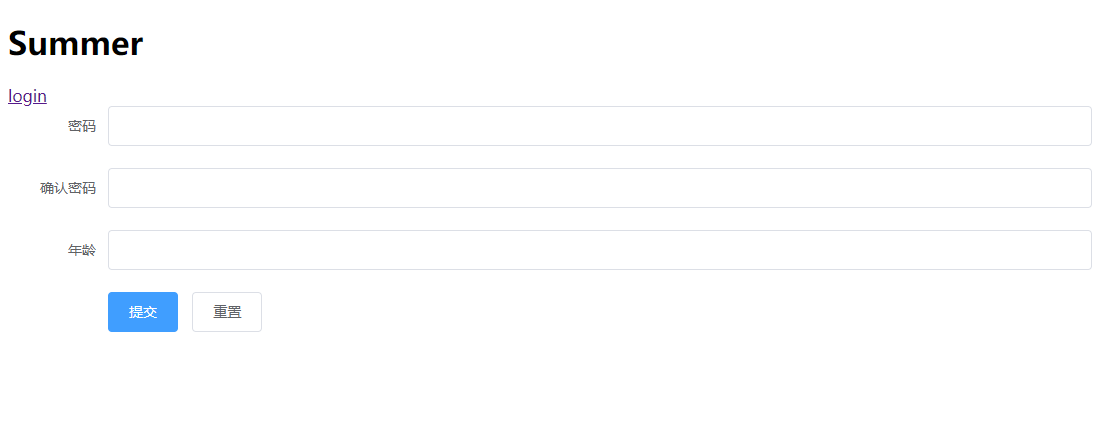
网站推荐
element-ui:
layui
layer 弹出层组件 - jQuery 弹出层插件 (layui.com)
docsify
Custom navbar (docsify.js.org)
路由嵌套
嵌套路由又称子路由,在实际应用中,通常有多层嵌套的组件而成。同样地,URL中各段动态路径也按某种结构对应嵌套的各层组件。例如:

用户登录/侧边栏
工程目录
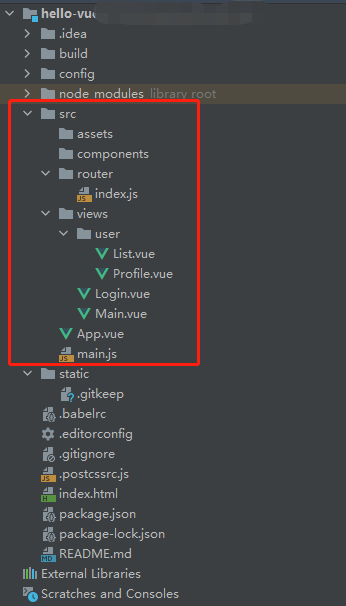
1、创建用户信息组件 views/user/Profile.vue
<template>
<h1>个人信息</h1>
</template>
<script>
export default {
name: "UserProfile"
}
</script>
<style scoped>
</style>
2、创建用户列表组件 views/user/List.vue
<template>
<h1>用户列表</h1>
</template>
<script>
export default {
name: "UserList"
}
</script>
<style scoped>
</style>
3、修改首页视图,views/Main.vue 用element-ui的侧边栏【布局容器组件】
<template>
<div>
<el-container>
<el-aside width="200px">
<el-menu :default-openeds="['1']">
<el-submenu index="1">
<template slot="title"><i class="el-icon-caret-right"></i>用户管理</template>
<el-menu-item-group>
<el-menu-item index="1-1">
<!--插入的地方-->
<router-link to="/user/profile">个人信息</router-link>
</el-menu-item>
<el-menu-item index="1-2">
<!--插入的地方-->
<router-link to="/user/list">用户列表</router-link>
</el-menu-item>
</el-menu-item-group>
</el-submenu>
<el-submenu index="2">
<template slot="title"><i class="el-icon-caret-right"></i>内容管理</template>
<el-menu-item-group>
<el-menu-item index="2-1">分类管理</el-menu-item>
<el-menu-item index="2-2">内容列表</el-menu-item>
</el-menu-item-group>
</el-submenu>
<el-submenu index="3">
<template slot="title"><i class="el-icon-caret-right"></i>系统管理</template>
<el-menu-item-group>
<el-menu-item index="3-1">用户设置</el-menu-item>
</el-menu-item-group>
</el-submenu>
</el-menu>
</el-aside>
<el-container>
<el-header style="text-align: right; font-size: 12px">
<el-dropdown>
<i class="el-icon-setting" style="margin-right: 15px"></i>
<el-dropdown-menu slot="dropdown">
<el-dropdown-item>个人信息</el-dropdown-item>
<el-dropdown-item>退出登录</el-dropdown-item>
</el-dropdown-menu>
</el-dropdown>
</el-header>
<el-main>
<!--在这里展示视图-->
<router-view />
</el-main>
</el-container>
</el-container>
</div>
</template>
<script>
export default {
name: "Main"
}
</script>
<style scoped lang="scss">
.el-header {
background-color: #72a3e0;
color: #333;
line-height: 60px;
}
.el-aside {
color: #333;
}
</style>
4、配置嵌套路由修改router/index.js 路由配置文件,使用children放入main中写入子模块
import Vue from "vue";
import VueRouter from "vue-router";
import Login from "../views/Login";
import Main from "../views/Main"
import List from "../views/user/List";
import Profile from "../views/user/Profile";
Vue.use(VueRouter);
export default new VueRouter({
routes: [
{
path: "/login",
component: Login
},
{
path: "/main",
component: Main,
//嵌套路由
children: [
{
path: "/user/profile",
component: Profile
},
{
path: "/user/list",
component: List
}
]
}
]
});
5、在views/Login.vue 用element-ui的组件
注:这里sass-loader版本过高 修改package.json版本号为4.0.0
<template>
<div>
<el-form ref="loginForm" :model="form" :rules="rules" label-width="80px" class="login-box">
<h3 class="login-title">欢迎登录</h3>
<el-form-item label="账号" prop="username">
<el-input type="text" placeholder="请输入账号" v-model="form.username"/>
</el-form-item>
<el-form-item label="密码" prop="password">
<el-input type="password" placeholder="请输入密码" v-model="form.password"/>
</el-form-item>
<el-form-item>
<el-button type="primary" v-on:click="onsubmit('loginForm')">登录</el-button>
</el-form-item>
</el-form>
<el-dialog title="温馨提示" :visible.sync="dialogVisiable" width="30%" :before-close="handleClose">
<span>请输入账号和密码</span>
<span slot="footer" class="dialog-footer">
<el-button type="primary" @click="dialogVisible = false">确定</el-button>
</span>
</el-dialog>
</div>
</template>
<script>
export default {
name: "Login",
data(){
return{
form:{
username:'',
password:''
},
//表单验证,需要在 el-form-item 元素中增加prop属性
rules:{
username:[
{required:true,message:"账号不可为空",trigger:"blur"}
],
password:[
{required:true,message:"密码不可为空",tigger:"blur"}
]
},
//对话框显示和隐藏
dialogVisible:false
}
},
methods:{
onSubmit(formName){
//为表单绑定验证功能
this.$refs[formName].validate((valid)=>{
if(valid){
//使用vue-router路由到指定界面,该方式称为编程式导航
this.$router.push('/main');
}else{
this.dialogVisible=true;
return false;
}
});
}
}
}
</script>
<style lang="scss" scoped>
.login-box{
border:1px solid #DCDFE6;
350px;
margin:180px auto;
padding: 35px 35px 15px 35px;
border-radius: 5px;
-webkit-border-radius: 5px;
-moz-border-radius: 5px;
box-shadow: 0 0 25px #909399;
}
.login-title{
text-align:center;
margin: 0 auto 40px auto;
color: #303133;
}
</style>
前端页面

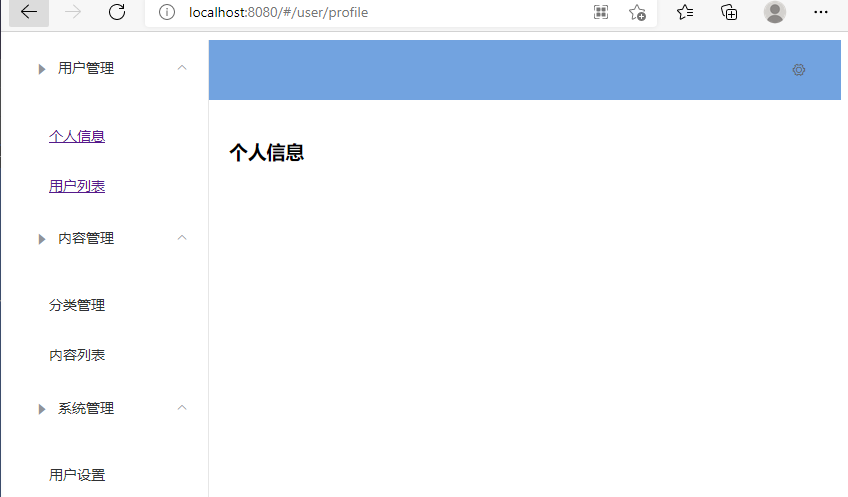
参数传递及重定向
路由模式与404
路由模式有两种
- hash:路径带#符号,如http://localhost/#/login
- history:路径不带#符号,如http://localhost/login
修改路由配置如下
export default new Router({
mode:'history',
routes:[
]
});
处理404创建一个名为NotFound.vue的视图组件,代码如下:
<template>
<div>
<h1>404~~你的页面走丢了</h1>
</div>
</template>
<script>
export default {
name: "NotFound"
}
</script>
<style scoped>
</style>
配置路由
import Vue from "vue";
import VueRouter from "vue-router";
import Login from "../views/Login";
import Main from "../views/Main"
import List from "../views/user/List";
import Profile from "../views/user/Profile";
import NotFound from "../views/NotFound";
Vue.use(VueRouter);
export default new VueRouter({
mode:'history',
routes: [
{
path: "/login",
component: Login
},
{
path: "/main/:username",
component: Main,
props:true,
//嵌套路由
children: [
{
//v-bind绑定的 :id 这边来接受
path: "/user/profile/:id",
name:'Profile',
component: Profile,
props:true
},
{
path: "/user/list",
component: List
},
{
path:"/goHome",
redirect:"/login"
}
]
},
{
path:"*",
component:NotFound
}
]
});
路由钩子与异步请求
beforeRouteEnter:在进入路由前执行
beforeRouterLeave:在离开路由前执行
上代码:
<template>
<!-- 所有的元素,必须不能在根节点下-->
<!-- 这边来展示-->
<div>
<h1>个人信息</h1>
<!-- {{$route.params.id}}-->
{{id}}
</div>
</template>
<script>
export default {
props:['id'],
name: "UserProfile",
//过滤器 chain
beforeRouteEnter:(to,from,next)=>{
console.log("进入路由之前");
//业务代码
next();
},
beforeRouteLeave:(to,from,next)=>{
console.log("进入路由之后");
//业务代码
next();
}
}
</script>
<style scoped>
</style>
参数说明:
- to:路由将要跳转的路径信息
- from:路由跳转前的路径信息
- next:路由的控制参数
- next() 跳入下一个页面
- next('/path') 改变路由的跳转方向,使其跳到另一个路由
- next(false) 返回原来的页面
- next((vm) => {}) 仅在beforeRouteEnter中可用,vm是组件实例
在钩子函数中使用异步请求
1、安装Axios
npm install --save axios vue-axios --registry=https://registry.npm.taobao.org
2、main.js 引用Axios
import Vue from 'vue'
import App from './App'
import router from "./router";
import ElementUI from "element-ui";
import 'element-ui/lib/theme-chalk/index.css';
import axios from 'axios';
import VueAxios from 'vue-axios'
//这里有顺序要求
Vue.use(VueAxios, axios);
Vue.config.productionTip = false
Vue.use(router);
Vue.use(ElementUI)
new Vue({
el: '#app',
template: '<App/>',
render: h => h(App),
router
})
3、profile.vue
<template>
<!-- 所有的元素,必须不能在根节点下-->
<!-- 这边来展示-->
<div>
<h1>个人信息</h1>
<!-- {{$route.params.id}}-->
{{ id }}
</div>
</template>
<script>
export default {
props: ['id'],
name: "UserProfile",
//过滤器 chain
beforeRouteEnter: (to, from, next) => {
console.log("进入路由之前");//加载数据
//业务代码
next(vm => {
vm.getData();
});
},
beforeRouterLeave: (to, from, next) => {
console.log("进入路由之后");
//业务代码
next();
},
methods: {
getData() {
this.axios({
method:"get",
url:"http://localhost:8080/static/mock/data.json"
}).then(function(response){
console.log(response.data);
});
}
}
}
</script>
<style scoped>
</style>
vue上项目
#使用这个命令必须 vue-cli是3.0+
vue create springboot-vue-demo
#--registry=https://registry.npm.taobao.org
npm uninstall vue-cli -g #先卸载
npm install @vue/cli -g #在安装
#报Python错 可cmd尝试如下命令
npm install --global --production windows-build-tools --registry=https://registry.npm.taobao.org
#还不可以 安装2.7的python
#https://blog.csdn.net/u011781521/article/details/53909151
#安装element-plus
#用 vue-cli 4 工具创建了一个 Vue3 项目
npm install element-plus --save
#main.js引入element-plus
import ElementPlus from 'element-plus';
import 'element-plus/lib/theme-chalk/index.css';
.use(ElementPlus)
mian.js
import { createApp } from 'vue'
import App from './App.vue'
import router from './router'
import store from './store'
import '@/assets/css/global.css'
import ElementPlus from 'element-plus';
import 'element-plus/lib/theme-chalk/index.css';
import 'dayjs/locale/zh-cn'
import locale from 'element-plus/lib/locale/lang/zh-cn'
createApp(App).use(store).use(router).use(ElementPlus, { locale ,size:"small"}).mount('#app')